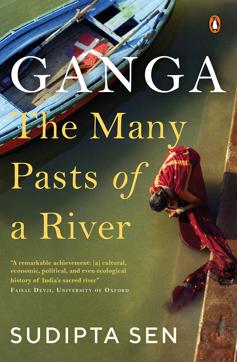Review: Ganga: The Many Pasts of a River by Sudipta Sen
Sudipta Sen’s comprehensive work on the river is certain to become one of the go-to books on studying the Ganga

In its heft, breadth and grandness of vision, this book must be one of the mightiest tomes on the Ganga. Over its 445 pages, 120 of which are dedicated to detailed endnotes, Sen portrays the story of the Ganga from as many angles as possible. Its mythology, topography, history from prehistory to current times, its connection to the Pleistocene, the many narratives that tie it to the formation of the Himalayan ranges, its linkage to the oldest of Puranas, the great epics, the rise of the great kingdoms on the Gangetic plains, and the beginnings of Buddhism, Jainism, the medieval and modern periods, all jostle for attention in this book. Sen must have spent a lifetime reading up on a majority of the scholastic debates and work related to the subject. This book is a monumental distillation of all that scholarship. While doing so, Sen often organically places the study of the river in comparative perspective. He has learned greatly from the scholarship on the river Nile and Amazon and from environmental history.
A work of historical scholarship, it pays obeisance to all that went before it. Sen is a meticulous historian who eschews relying on a single source or two about some important aspect about the river. He usually combs through many works to get to the spirit of an argument. The range of his reading and the rigour behind backing up so many of his assertions makes for patience-testing, even dry and sometimes stodgy academic reading. But that is the point of historical work. While the genre of nonfiction may be capacious, this book offers small doses of it and bases itself on large and wide scholastic work that extends from science, archaeology, architecture, zoology, and geology to social sciences and humanities. An essential quality of works like these is a kind of boredom with the sheer exhaustiveness of details. This results in a constant turning of the pages to the endnotes. As a reading experience, this book is exasperating as well as exhilarating. But rarely are the best experiences of such scholarship tailor-made and customised to please, made to order. The uncompromising intellectual demands of Ganga: The Many Pasts of a River are its strengths. It will force the reader to read so much more about the Ganga and other rivers.

Some of the real takeaways for this reader were the mysterious nature of Ganga’s water, extremely polluted in parts of the Uttar Pradesh plains due to industrial effluents, and the ways in which it still remains potable and portable. The story of the “Descent of the Ganga” and the thrilling narratives around it – famously, even a part of Pallava-created Mahabalipuram celebrates the river’s descent. For Sen, many major features of Indian society appear connected to the many moods and moves of the river. Like the epics that are told and retold across India’s diverse cultures and languages, each region where the river flows, seems to create an image of the river in its own fashion. The many names of the river in different regions is a fascinating facet of its many identities. Sen traces the history behind these. He spends time and space studying the Ganga’s regional identities through historic epochs and spends a large chapter on the formation of the socio-economic foundation for the Gangetic plain to support millennia of population and over population. While the encounter with the West and with the British opened up more scientific methods of studying the river, Sen points out that it also came with Orientalist judgment.
Read more: Review: Bastar Dispatches by Narendra
A comprehensive work, this is certain to become one of the go-to books on studying the Ganga. Large parts rely on solid secondary sources and the efforts of those who have scrutinised it from the vantage of their subject area. Still, this reader wonders what Sen’s hypothesis is? What is he aiming to prove or disprove here? In what way does it add to what branch of literature on the Ganga? There are no clear answers. If anything, Sen’s point seems to be to write a textbook on the Ganga on almost all of its relevant features and debates. This book gives the huge and exciting scholarship on the Ganga a systematic and relevant chronology across disciplines. If ever Sen, an university academic, offers an elective course on studying the river, this reader would be the first to sign up for it, hoping he’s not the only one.
Rahul Jayaram teaches at Jindal School of Liberal Arts & Humanities






